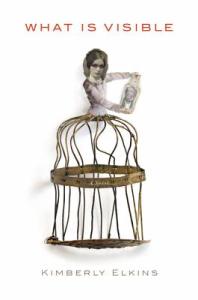By: Kimberly Elkins
Twelve, 2014
320 pages
Reviewed by Clifford Garstang
Probably you’ve heard of Helen Keller, the deaf and blind girl who was educated at the Perkins Institution for the Blind in Boston and eventually became a prolific writer and activist. Her story is familiar to us through The Miracle Worker, the play and movie that also showcased Keller’s dedicated teacher, Anne Sullivan. But chances are you are unfamiliar with Laura Bridgman, another deaf and blind girl who preceded Keller at Perkins. Bridgman is the subject of Kimberly Elkins’s remarkable debut novel, What is Visible.
It’s a fascinating story. Like Keller, Bridgman was born with her senses intact but was robbed of hearing and sight (she also lost her senses of taste and smell) during a childhood bout with Scarlet Fever. Unable to help her at home, Bridgman’s parents eventually put her into the care of Samuel Gridley Howe, the director of Perkins, which he founded in 1829. Dr. Howe taught her to communicate using a combination of hand-spelling (a kind of sign language pressed directly into the palm of the hand) and raised-letter printing (as opposed to Braille, which the school did not adopt until later). Because of their success, Howe and Bridgman were somewhat famous for a time in the mid-Nineteenth Century and came into contact with numerous celebrities and political figures of the day, many of whom make appearances in the novel.
What is Visible sticks closely to Bridgman’s history. Unlike the The Miracle Worker, though, which was based on Keller’s autobiography, this book takes some liberties with the historical record, and also creates imagined interior lives for many of its characters. For the most part, these characters are real historical persons. Besides Bridgman and Howe, the novel features Julia Ward Howe, Dr. Howe’s socialite wife who became well known as a poet (she wrote “The Battle Hymn of the Republic”) and abolitionist. Whatever may have been the case in reality, in the novel Julia Howe is not shown in a favorable light. Although occasionally sensitive to Bridgman’s needs, she is self-centered, jealous of the attention Laura demands, and is also repulsed by the girl’s inability to control herself. Later, estranged from Dr. Howe, Julia settles with her children in Italy and begins a scandalous relationship with an American writer. Dr. Howe is also flawed, at least in the novel. An egomaniac, he responds to rumors of his wife’s infidelity by engaging in his own extramarital affairs and, it is suggested, fathering at least one child out of wedlock. All of which makes for good reading, regardless of what actually happened.
But the primary focus of the novel is on Bridgman herself—her struggles to cope with an isolation that few of us can even imagine, her constant frustration, and her anger. She longs for her family, but, except for her sister, is rejected by them. She wants to be part of Dr. Howe’s family, but Julia Howe forbids it. She wants to be close to the blind girls in the school, but to them she is a nuisance. Over Dr. Howe’s objections, she turns to God for solace, but is repeatedly disillusioned in her faith by one tragedy after another.
 It is only when Laura meets Kate, an Irish orphan who is hired to help in the Perkins kitchen, that she experiences real, requited love and sexual intimacy. And yet Kate and this relationship are entirely the author’s invention—something to relieve the bleakness of her protagonist’s existence, Elkins suggests in an afterword—and Bridgman’s lesbianism is purely speculative, if absolutely plausible.
It is only when Laura meets Kate, an Irish orphan who is hired to help in the Perkins kitchen, that she experiences real, requited love and sexual intimacy. And yet Kate and this relationship are entirely the author’s invention—something to relieve the bleakness of her protagonist’s existence, Elkins suggests in an afterword—and Bridgman’s lesbianism is purely speculative, if absolutely plausible.
Novels based on historical figures and events face the same challenge that any family saga does: Interesting events don’t always translate into compelling stories. It is the task of a writer working with such material to ensure that the telling of the story, using conflict and suspense, is sufficiently dramatic to keep the reader’s interest, and that the characters on the page are round and credible, whether or not they were in real life. Elkins has done her homework—the research for a project like this must be daunting—but she has also allowed her imagination to create a plot and characters worthy of the very best novels.


Pingback: 2015 Reading: What is Visible by Kimberly Elkins | Clifford Garstang
Does the novel cover Laura Bridgman’s adult life? I’m curious to know what she did as a mature woman.
LikeLike
It does, Sally, although most of that is covered in summary or with a jump forward in time.
LikeLike
I loved this book — how deeply it delved into Laura Bridgman’s psyche, and how complex a life Elkins gives her, siphoning all her emotions through her only sense, touch.
LikeLiked by 1 person